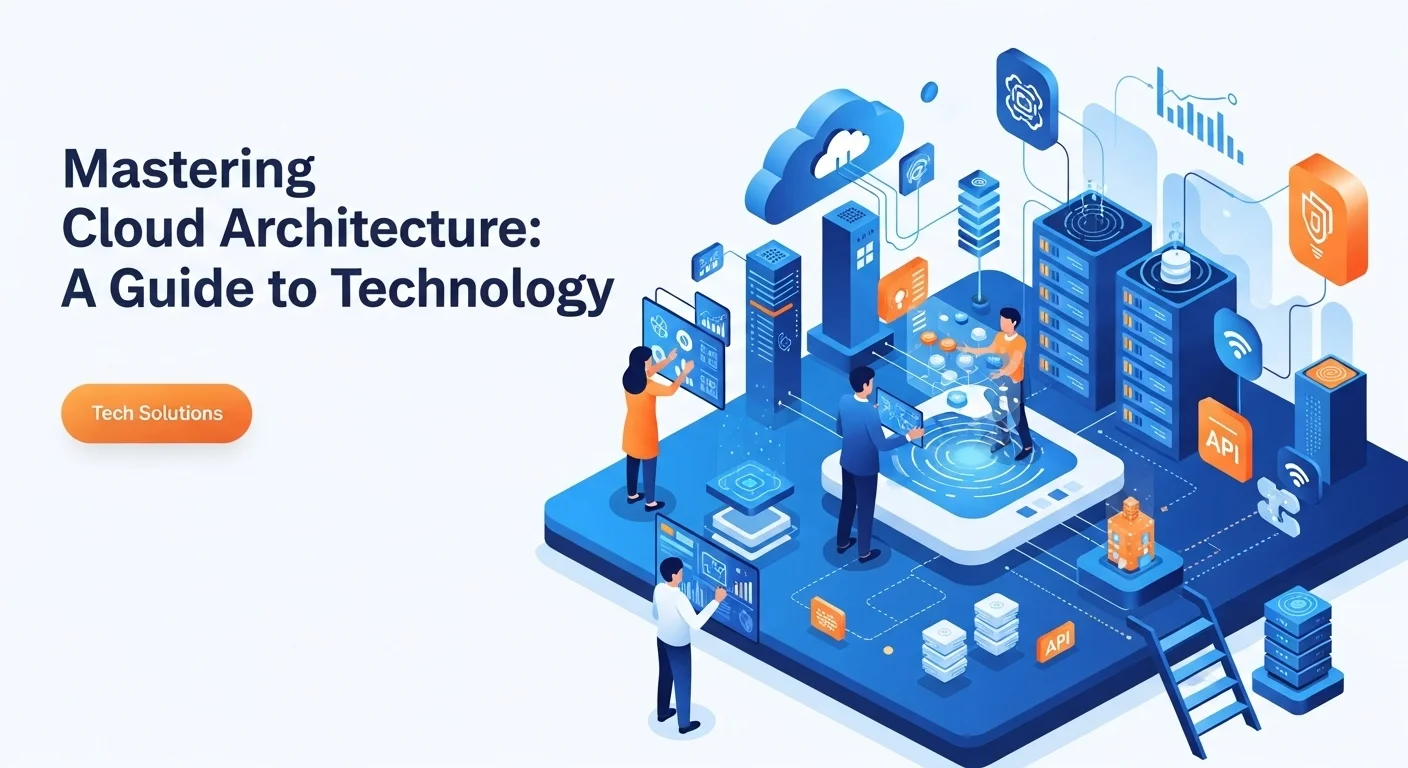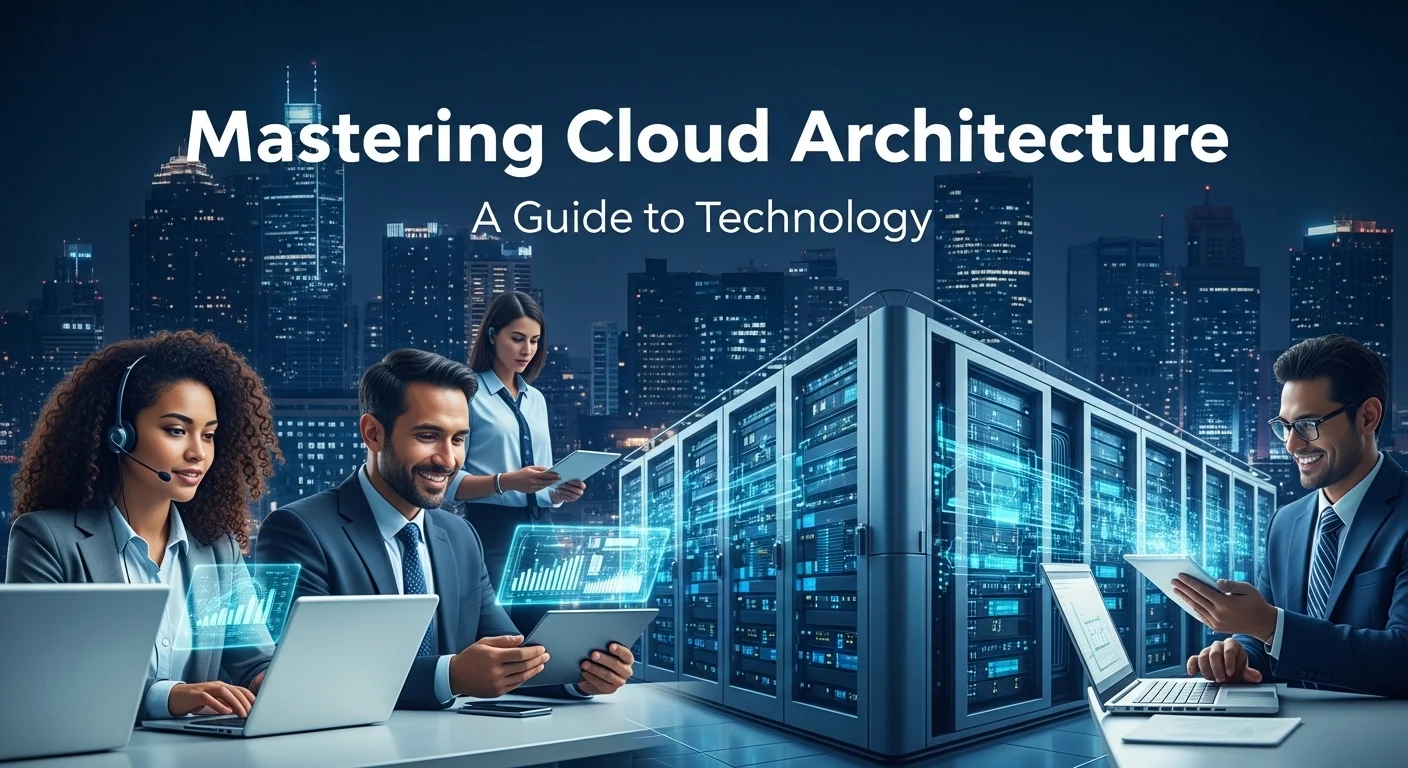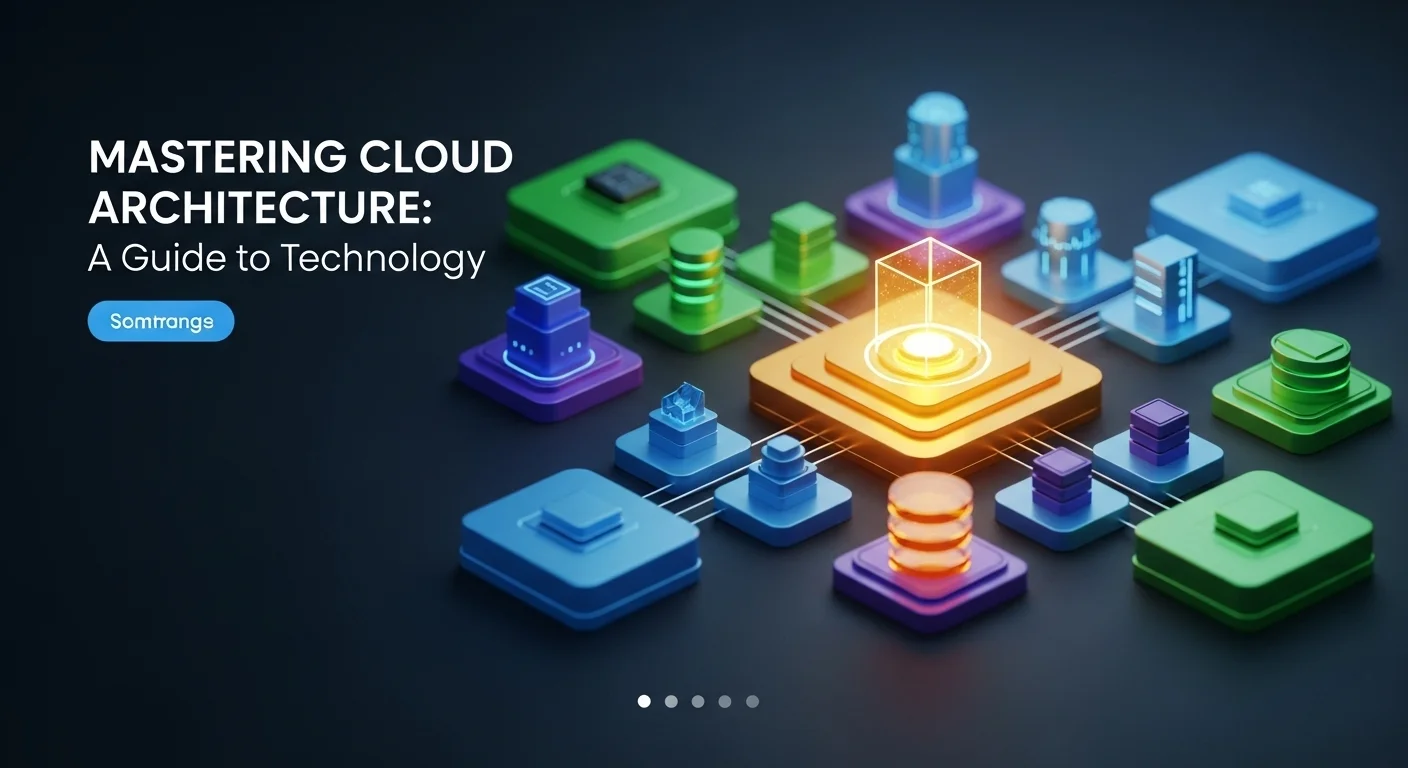Cloud Architecture Explained: A Real-World Guide for Tech Leaders

Executive Summary
In my 15 years as a cloud architect, I've seen countless businesses get lost in the complexities of 'the cloud.' It's a term we hear everywhere, but what does it really mean to build something *in* it? Cloud architecture isn't just a technical blueprint; it's the very foundation of how modern companies innovate, scale, and compete. This article is my attempt to cut through the noise. I'll guide you through what cloud architecture actually is, breaking down its essential parts like frontend and backend platforms, delivery models, and the network that ties it all together. A solid architectural plan is the difference between a system that soars and one that struggles. It's the key to achieving real scalability, cost savings, agility, and security. We'll explore the different environments—public, private, hybrid, and multi-cloud—and demystify the service models like IaaS, PaaS, and SaaS. Whether you're a tech enthusiast or a business leader, understanding these concepts is no longer just an option; it's essential for success. Think of this as your personal roadmap to mastering the cloud and using its power to transform your business.
Table of Contents
Table of Contents
- What is Cloud Architecture and Why Does It Matter?
- Understanding the Core Components
- Diving Deeper into Service and Software Architectures
- Technical Methods and Architectural Patterns
- Business Techniques for Cloud Adoption
- Comparing the Major Cloud Providers
- Best Practices for a Resilient Architecture
- Strategies for Security and Compliance
- Cost Optimization and FinOps
- Embracing the Future: AI and Edge Computing
What is Cloud Architecture and Why Does It Matter?
In a world running on digital, the word 'cloud' is everywhere. But behind that simple term is a powerful and complex framework called Cloud Architecture. I like to think of it as the detailed blueprint for a digital skyscraper. It lays out exactly how all the technological pieces—hardware, software, networking, and virtualization—fit together to create a functional cloud environment. It’s the master plan that defines the relationship between the user-facing part (the frontend), the powerful machinery behind the scenes (the backend), the delivery model, and the network connecting them. Without this solid plan, any digital service would be unstable, inefficient, and unable to grow. This foundational design is what makes it possible to deliver computing services on demand, from applications to storage, over the internet—a model that has completely changed the game for technology.
The importance of a well-thought-out cloud architecture simply can't be overstated. It's the key that unlocks the incredible benefits we always hear about: scalability, cost-efficiency, agility, and resilience. I remember the pre-cloud days when businesses had to sink huge amounts of cash into physical servers and on-site infrastructure. It was expensive and incredibly rigid. If you had a sudden spike in traffic, scaling up was a slow, painful, and costly process. A strong cloud based architecture completely flips that script. It lets organizations add or remove resources automatically based on real-time demand, and you only pay for what you actually use. This flexibility not only saves a ton of money by turning capital expenses into operational ones, but it also gives businesses the agility to innovate and react to market shifts at a speed that was once unimaginable. By tapping into the massive, distributed infrastructure of cloud providers, companies can also achieve incredible performance and reliability, ensuring their services are always on for customers anywhere in the world.
Understanding the Core Components
To really get it, let's break down the main components. These elements work together like a well-oiled machine to deliver a seamless cloud experience.
- Frontend Platform: This is the client side of the architecture—everything the user sees and interacts with. It includes the user interface, the mobile or web app, and the device you're using (like your phone or laptop) to access the cloud. For instance, when you open an app like Uber or Spotify, you're interacting with the frontend.
- Backend Platform: This is the cloud itself, managed by the service provider. It contains all the horsepower needed to run the service: huge data centers filled with servers, massive storage systems, virtualization software, security systems, and management tools. The backend does all the heavy lifting, like processing your requests, storing your data, and making sure everything runs smoothly.
- Cloud Delivery Model: This defines how cloud services are offered. Choosing the right one is a huge architectural decision. The main models are Public, Private, and Hybrid clouds. Public clouds (like AWS, Google Cloud, Microsoft Azure) are owned by third-party providers and offer services over the public internet. Private clouds are built exclusively for a single organization, giving them more control. Hybrid clouds are a mix of both, letting data and apps move between them for the perfect balance of flexibility and security. A popular trend now is the multi-cloud model, which means using services from several public cloud providers to get the best of all worlds and avoid being locked into one vendor.
- Network: The network is the glue that holds the cloud architecture together, connecting the frontend and backend. It's made up of the internet, which lets you access the cloud, and the internal high-speed networks within the provider's data centers. A fast, reliable network is absolutely critical for data to move quickly between you and the cloud's resources.
Diving Deeper into Service and Software Architectures
Within the main cloud architecture, there are specific designs for how different technology layers are managed. Understanding these is key to making smart choices.
A core concept is the cloud service architecture, which breaks down into three main models: Infrastructure as a Service (IaaS), Platform as a Service (PaaS), and Software as a Service (SaaS).
- IaaS (Infrastructure as a Service): This model gives you the raw building blocks of computing: servers, storage, and networking on demand. With IaaS, you're essentially renting the IT hardware. This offers the most control over the operating system and applications but also means you have more to manage yourself.
- PaaS (Platform as a Service): PaaS gives you a complete development and deployment environment in the cloud. It includes the underlying infrastructure plus a platform with software tools to build, test, and manage your apps. This is a developer's dream because they can focus purely on coding without worrying about managing servers.
- SaaS (Software as a Service): SaaS delivers ready-to-use software applications over the internet, usually on a subscription basis. The cloud provider handles everything—the app, the data, the servers. You just log in and use it through your web browser. Think of services like Google Workspace, Salesforce, or Dropbox.
The cloud software architecture is all about how the applications themselves are built to thrive in the cloud. This has changed dramatically from the old monolithic approach. A monolithic app is built as one big, single unit. It’s simple at first, but becomes a nightmare to scale, update, and maintain. In contrast, modern cloud software often uses a microservices pattern. Here, the application is broken into a collection of small, independent services. Each service handles one job, runs on its own, and talks to the others over a network. This gives you incredible flexibility, as each service can be updated, deployed, and scaled independently. It's a cornerstone of building resilient, agile, cloud-native apps.
The cloud platform architecture is the environment provided by giants like AWS, Azure, and GCP. It includes the hardware, operating systems, databases, and other tools developers use. A major innovation here is the use of containers, orchestrated by platforms like Kubernetes. Containers package an application’s code and all its dependencies together, guaranteeing it runs the same way everywhere. This has become the standard for deploying apps in the cloud, offering amazing portability and efficiency.
Finally, cloud networking architecture is a specialized field focused on designing the network inside the cloud. This is much more than just plugging in servers. It involves creating isolated virtual networks (VPCs), setting up load balancers to distribute traffic, configuring DNS for routing, and building firewalls to block threats. A well-designed cloud network is non-negotiable for security, performance, and reliability, ensuring data flows safely and efficiently across your entire cloud environment.

Complete guide to Cloud Architecture in Technology and Business Solutions
Diving deeper into cloud architecture, we move from the 'what' to the 'how.' Mastering this field means knowing how to assemble the right components into a system that is not only technically sound but also perfectly aligned with your business goals. This is where experience really comes into play. Let's explore the technical methods, business strategies, and real-world tools that form the backbone of modern cloud solutions.
Technical Methods: Architectural Patterns and Paradigms
The move to the cloud has forced us to rethink how we design software. The architectural pattern you choose is one of the most critical decisions you'll make when building a cloud-native application.
Monolithic vs. Microservices Architecture
The classic debate in cloud software architecture is monolithic versus microservices. I've worked on projects using both, and the difference is night and day.
- Monolithic Architecture: In this traditional model, the entire application is a single, tightly-coupled unit. In the early days, this was fine. But in the cloud, it's a liability. To scale, you have to clone the whole application, even if only one tiny feature is getting hammered with traffic. Deploying a small change is a high-stakes event, requiring a full redeployment. I once worked on a monolith e-commerce site where a bug in the coupon-code feature could bring down the entire checkout process. It was a constant source of stress.
- Microservices Architecture: This modern approach breaks an application into a collection of small, independent services. Each service focuses on one business function, has its own data, and communicates with others using APIs. This is a perfect match for a cloud based architecture. You can scale only the services that need it. Teams can work independently, pushing updates much faster. It improves resilience, too; if one service has an issue, it doesn't have to take down the whole app. It does add complexity, but the gains in agility and scalability are almost always worth it.
Serverless Computing (Function as a Service - FaaS)
Serverless computing is the next step in this evolution, taking even more infrastructure management off our plates. With a serverless model, we write code as small functions that run in response to events—like a new user signing up or a file being uploaded. The cloud provider handles everything else. They spin up the resources to run the function and shut them down immediately after. As a developer, it feels like magic. You don't manage any servers, virtual machines, or containers. This approach offers incredible scalability and cost savings because you literally only pay for the compute time you use, down to the millisecond. It's perfect for APIs, data processing tasks, and anything event-driven.
Containerization and Orchestration
Containers, especially Docker, have become a fundamental part of cloud platform architecture. A container packages an application's code with all its dependencies into a single, portable unit. This solves the classic 'it works on my machine' problem. But when you have hundreds or thousands of containers, you need an orchestrator. Kubernetes has won that war and is now the industry standard. It automates the deployment, scaling, and management of containerized applications. It handles things like load balancing, restarting failed containers, and rolling out updates seamlessly. This combo of containers and Kubernetes gives you a powerful and portable foundation to run your apps on any cloud.
Business Techniques for Cloud Adoption
For a business, moving to the cloud is a strategic journey. There are a few common migration strategies I've helped companies navigate:
- Lift-and-Shift (Rehosting): This is the quickest way to the cloud. You basically copy and paste your existing applications from your data center to cloud infrastructure with few changes. It's fast, but it often misses out on cloud-native benefits and can lead to higher costs down the road because the apps aren't optimized for the new environment.
- Re-platforming (Lift-and-Tinker): This is a middle ground. You make some smart optimizations during the migration. For example, moving from a self-managed database to a managed cloud database service like Amazon RDS. It strikes a good balance between speed and getting more value out of the cloud.
- Refactoring/Re-architecting: This is the most involved approach, where you completely redesign the application to be cloud-native. This usually means breaking a monolith into microservices. It's a big investment, but it's how you unlock the full power of the cloud in terms of scale, resilience, and agility.
Resources and Comparisons: The Major Cloud Providers
The cloud market is dominated by three giants: Amazon Web Services (AWS), Microsoft Azure, and Google Cloud Platform (GCP). Each offers the building blocks for any cloud based architecture.
Amazon Web Services (AWS)
As the pioneer and market leader, AWS has the most extensive and mature portfolio.
- My Take: AWS is like a massive, well-stocked hardware store. It has a tool for everything. Its maturity means there's a huge community and a wealth of documentation for any problem you might encounter. For startups and teams that want the widest array of services and a proven track record, AWS is often the default choice. Their cloud networking architecture with VPC is incredibly powerful for creating secure environments.
Microsoft Azure
Azure is a powerhouse, especially for enterprises already deep in the Microsoft ecosystem.
- My Take: If your company runs on Windows Server, Active Directory, and Office 365, Azure offers a seamless transition to the cloud. The integration is its killer feature. I often recommend Azure to large organizations looking to build a hybrid cloud strategy, as it excels at bridging the on-premises world with the cloud.
Google Cloud Platform (GCP)
GCP's strengths lie in the areas where Google dominates: networking, big data, machine learning, and containers.
- My Take: GCP is the innovator's choice. They created Kubernetes, and their Google Kubernetes Engine (GKE) is arguably the best managed Kubernetes service out there. If you're building a container-heavy application, GCP is hard to beat. Their expertise in data analytics with tools like BigQuery and their top-tier global network also make them a fantastic choice for data-intensive, low-latency applications.
Choosing a provider isn't just about features; it's about cost, global presence, and your team's existing skills. In my experience, more and more companies are adopting a multi-cloud strategy, picking and choosing the best services from each provider. This strategic approach is the mark of a truly mature cloud architecture strategy.

Tips and strategies for Cloud Architecture to improve your Technology experience
Getting your cloud architecture right isn't a one-and-done task. It's a living system that needs continuous refinement. From my years in the trenches, I can tell you that the best architectures are those that are planned, built, monitored, and optimized in a constant cycle. Here are some of the most important lessons and strategies I've learned for building a cloud environment that is secure, resilient, cost-effective, and high-performing.
Best Practices for a Resilient and Scalable Architecture
Your architecture must be able to handle failures and grow with your business. These principles are non-negotiable for a solid cloud based architecture.
- Design for Failure: This is the golden rule of the cloud. Don't pretend things won't break—they will. I once saw an entire data center region go down, but one of my client's systems stayed online because we had designed it to fail gracefully. We deployed redundant resources across multiple availability zones (separate data centers). When one zone failed, traffic was automatically rerouted to the healthy ones. Use load balancers to distribute traffic and automatically remove unhealthy servers from the pool.
- Embrace Elasticity with Auto-Scaling: Stop guessing your peak traffic. Let automation handle scaling for you. Auto-scaling groups can add or remove servers based on real-time metrics like CPU usage. This means you always have enough power to handle a surge, but you're not wasting money on idle servers during quiet periods. This is a core advantage of a well-tuned cloud platform architecture.
- Decouple Your Components: Loosely coupled services are the secret to resilience. Use message queues (like AWS SQS or Azure Queue Storage) to let different parts of your system communicate without being directly connected. If one service goes down, messages just wait in the queue to be processed later. This prevents a single failure from causing a domino effect across your entire application. It's a key pattern in any modern cloud software architecture.
- Let the Provider Do the Heavy Lifting: Use managed services whenever you can. Instead of spending your team's time patching and backing up a database server, use a managed PaaS solution. I've seen teams reclaim hundreds of hours per year by offloading this work to the cloud provider, allowing them to focus on building features that actually make the company money.
Strategies for Security and Compliance
Security isn't something you bolt on at the end; it's the foundation of your entire cloud architecture. You need a proactive, multi-layered approach.
- Practice Defense in Depth: Apply security at every single layer. It starts with your cloud networking architecture, using firewalls and network rules to control traffic. It continues with the operating system, your application code, and the data itself. The goal is that a breach at one layer doesn't compromise the whole system.
- Implement the Principle of Least Privilege: This is one of the most effective security measures. Give every user and every service the absolute minimum permissions needed to do their job, and nothing more. Use Identity and Access Management (IAM) tools to create very specific roles. Never use the root account for daily tasks. This drastically limits the damage an attacker can do if an account is compromised.
- Encrypt Everything, Everywhere: Data must be protected whether it's moving or sitting still. Use TLS/SSL to encrypt data in transit between users and servers. Use services like AWS KMS or Azure Key Vault to encrypt data at rest in your databases, storage buckets, and server disks.
- Automate Security and Compliance: Manually checking for compliance with standards like GDPR or HIPAA is a recipe for disaster. Use cloud tools (like AWS Config or Azure Policy) to constantly scan your environment for policy violations and even fix them automatically. Set up robust logging and monitoring so you can detect and respond to threats in real time.
Business Tools and Cost Optimization (FinOps)
Cloud costs can spiral out of control if you're not careful. The discipline of managing this is called FinOps, and it's essential for any business in the cloud.
- Visibility Through Tagging: The first rule of cost control is: you can't manage what you can't measure. The first thing I do with any new client is implement a strict tagging strategy. Every single resource gets tagged with its owner, project, and cost center. This lets you see exactly where the money is going.
- Use Cost Optimization Tools: Your cloud provider gives you tools like AWS Cost Explorer or Azure Cost Management. Use them. They will help you find idle resources, recommend smaller instance sizes, and suggest cost-saving plans like Reserved Instances for predictable workloads. Third-party tools can offer even deeper insights.
- Build a Cost-Aware Culture: FinOps is more about culture than tools. I've found the most successful companies are those that give their engineering teams visibility into and responsibility for their own cloud spending. When cost becomes a metric they are judged on, right alongside performance, they start building more efficiently.
Embracing the Future: AI and Edge Computing
Cloud architecture never stands still. A smart strategy always looks ahead. Artificial Intelligence (AI) and Machine Learning (ML) are now standard features of a modern cloud service architecture, with providers offering incredible platforms to build and deploy ML models. Edge computing is another game-changer, moving processing power closer to where data is created to reduce latency. By designing a flexible architecture today, you'll be ready to adopt these powerful technologies tomorrow. For those who want to explore the technical patterns behind these advanced systems, the AWS Architecture Center offers fantastic guidance and reference designs, like their guide to Cloud Design Patterns, which I consider an essential resource for any cloud architect.
Expert Reviews & Testimonials
Sarah Johnson, Business Owner ⭐⭐⭐
This was a good overview of Cloud Architecture. As a business owner, I would have loved to see a few more real-world case studies to connect the dots.
Mike Chen, IT Consultant ⭐⭐⭐⭐
A really solid article on Cloud Architecture. It helped clarify a lot for me as a consultant, though a couple of the deeper technical concepts could have been broken down a bit more.
Emma Davis, Tech Expert ⭐⭐⭐⭐⭐
Fantastic piece! As a tech specialist, I found it comprehensive and incredibly clear. It's a great resource for anyone in the field. Perfectly explained!



